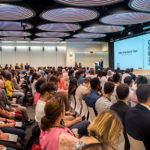Collision, a startup technology conference created by Dublin-based Web Summit — itself a cutting-edge tech conference — has made its mark in just two short years. Billed by USA Today as “the anti-CES [Consumer Electronics Show],” Collision is purpose-built to be smaller and smarter than the tech megaconference, offering startups the opportunity to present their ideas to venture-capital firms. “Collision is the fastest-growing tech conference in America,” said Paddy Cosgrave, Web Summit’s CEO. “We intertwine tech ecosystems across the globe, allowing the business leaders of today to meet the innovators of tomorrow.”
It’s a growing market. Collision has seen attendance quintuple, from 1,500 in 2014 to 7,500 at its 2015 show, held at the World Market Center Las Vegas. “We expect up to 15,000 attendees at Collision 2016,” Cosgrave said, “including 750 of the world’s best media, 500 angel investors and venture capitalists from the biggest firms, and over 1,000 of the most promising startups from across the globe.”
Organizers say a big part of the attendance bump can be attributed to Office Hours, Web Summit’s proprietary data system, which is designed to match investors and startups, then schedule meetings between them well in advance of the show. In the months leading up to Collision 2015, organizers collected detailed information from attendees on their products, expertise, and areas of interest to facilitate as many short “matchmaking” meetings as possible.
We fixate on helping you find the right people and ideas from millions of possible connections and conversations.
“Our data-science team works on algorithms that allow our attendees to match up and make valuable connections,” Cosgrave said. “Throughout all of our events, we obsess over detail and we constantly try to add value for our attendees.” Although the Web Summit team keeps a tight lid on how exactly the algorithm behind Office Hours works, they credit its success to “engineering serendipity.” “We fixate on helping you find the right people and ideas from millions of possible connections and conversations,” Cosgrave said. “Our answer is intimacy, powered by great design and detailed data science.”
Office Hours is also used at Web Summit itself, plus at the brand’s other events — SURGE, which debuted in Bangalore, India, this past February, and RISE, launched in Hong Kong last July. At Collision 2015, it facilitated 600 meetings with companies such as Sequoia, Accel, 500 Startups, and a16z. The program was such a success that it’s being expanded for Collision 2016, which will be held in New Orleans this month. “As a company,” Cosgrave said, “we are always looking for new ways to engineer our events in order to perfect our gatherings and find new ways to connect our attendees.”



